

| Circe
| Thursday, September 3, 2009 I continued work on the main bulkheads, beginning with the usual water wash and light sanding of the new tabbing on the aft side of the bulkhead sections. After cleaning up, I marked and trimmed the inside edges of the bulkheads to create a new, wider passageway to the forward part of the boat. The new passageway was 20" wide, an increase of 4-5" over the old. I determined a centerline on the boat, and marked a point on each bulkhead 10" from here, from which I struck plumb lines down the bulkhead faces; then, I sawed the bulkhead to these lines. |
|
Before continuing with the bulkhead work, I took a detour to create a basic mockup of a new idea in the cockpit: extend the rudderpost to the aft deck, and install the tiller there. A reader familiar with the project suggested this idea, and I felt it had excellent potential since it would open up seating space at the forward end of the cockpit. During a meeting with the owners last weekend, we'd determined that the originally-planned wheel steering was simply not going to work effectively and create the effect the owners wanted, so we reverted to the original tiller, while at the time still planning on modifying the aft end of the cockpit to create additional seating there, as well as rebuilding and reshaping the cockpit coamings according to the mockup I'd built earlier. The original idea behind the pedestal, and the additional seating areas, had been to create more comfortable (and less in-the-way) seating areas for guests on board; the original cockpit-sweeping tiller certainly could limit such seating. Eliminating the pedestal and reverting to the tiller, while greatly simplifying the project and remaining true to the boat, still required the idea of extending the seating areas aft, behind the rudderpost, so that there might be comfortable room for people out of the way of the sailing business of the boat. By considering the possibility of moving the tiller aft, to deck height, the helmsman position could be effectively moved significantly aft, with a corresponding gain in seating space at the forward end of the cockpit. When I mentioned the idea, the owner was intrigued, so I took a few minutes to install a broom handle to simulate the rudderpost's position, and hot-glued a "tiller" to the deck in the correct position to show how the idea might pan out. In these photos, the tiller avatar is 42" long, since that was the length of the scrap that I used, but the actual tiller could be a bit shorter, around 36" or so, gaining even more space. Even the long tiller left at least 24" of clear cockpit well space forward of its end, a significant improvement over the original tiller position. This tiller position would require repositioning the mainsheet traveler to the coachroof, a change we'd already been planning all along, so there was no additional sacrifice or compromise required. After additional discussion, we ultimately decided to proceed in this direction. In addition, the owner decided to stick with the original wooden coaming design, rather than the new, wider, fiberglass version, since now the aft end of the cockpit would not be under modification, and we felt we could create a slightly longer winch island upon which the helmsman could perch if desired--all the more so now that the helm position was further aft. Projects of this nature are nothing if not fluid of concept, and should be. |
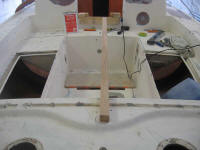
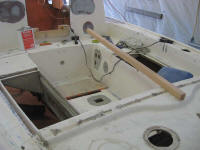
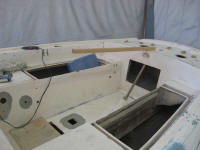 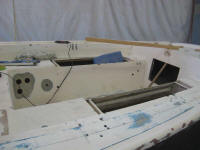
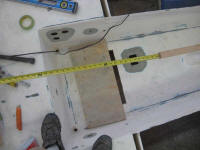
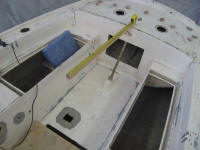 |
|
For the remainder of the morning and through the afternoon, I continued the new bulkhead installation on the forward side, proceeding much as I did yesterday. I installed epoxy fillets between the bulkhead and hull/deck, cut enough fiberglass tabbing for the job, and then installed all the tabbing: 3 layers, up to 12", on the hull, and two 6" layers on the deck. |

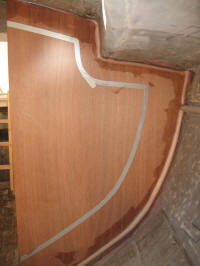 
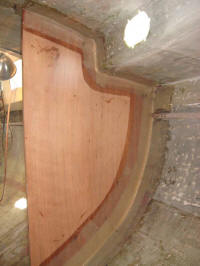 |
|